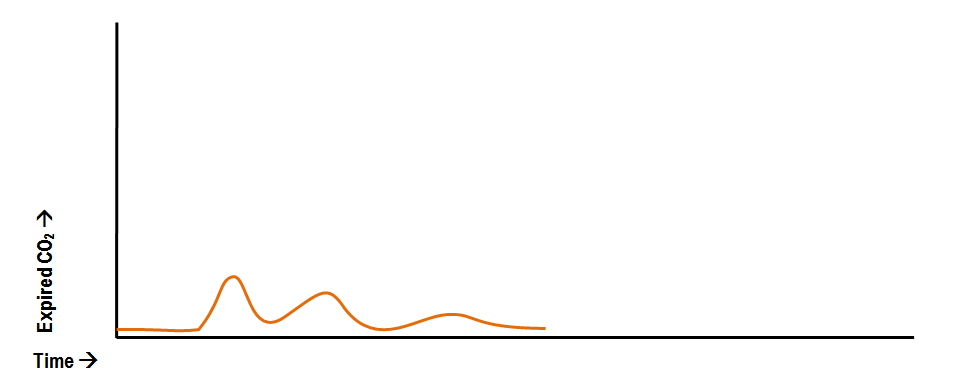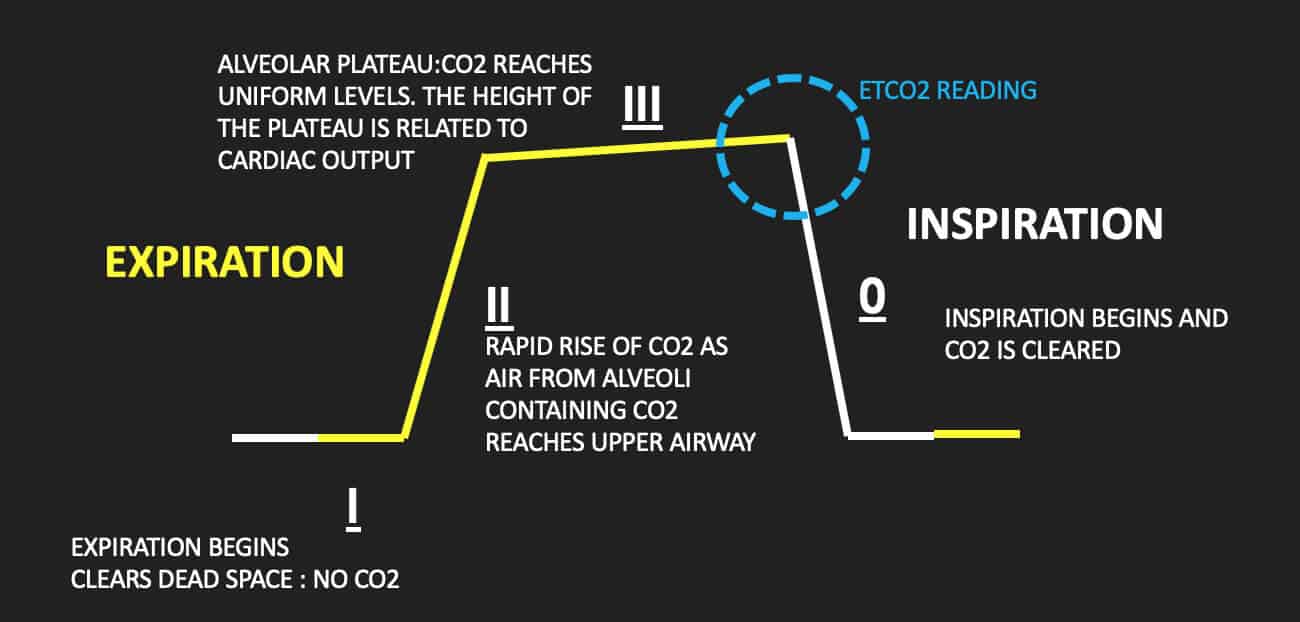normal end tidal co2 after intubation
Main outcome measures The time following intubation for ETCO 2 levels to be initially detected and to reach 4 mm Hg and 15 mm Hg. End-tidal carbon dioxide is better than arterial pressure for predicting volume responsiveness by the passive leg raising test.

Waveform Capnography In The Intubated Patient Emcrit Project
Waveform capnography represents the amount of carbon dioxide CO 2 in exhaled air which assesses ventilation.

. End tidal CO 2 monitoring is represented as a number and a graph on a monitor. 423 20 mmHg versus 34 255 mmHg. End tidal normally 2-5 mmHg lower than arterial Comparing Arterial and End-tidal CO2 Review of Airway Confirmation Visualization Auscultation.
Norm al EtCO2 levels 46 to 60 kPa. After placement of the endotracheal tube an end-tidal carbon dioxide recording of 35 mm Hg with a normal square wave tracing was observed on the Datex monitor Datex Helsinki. Changes in the shape of the capnogram are diagnostic of disease conditions while changes in end-tidal CO 2 EtCO 2 the maximum CO 2 concentration at the end of each tidal.
Results The median time for initial detection of ETCO 2. The number is called capnometry which is the partial pressure of CO 2 detected at the end of exhalation. End-tidal CO2 measurement in the detection of esophageal intubation during cardiac arrest.
In mmHg the PetCO2 values for those with and without ROSC after five minutes of CPR was. The presence of a normal waveform denotes a patent airway and spontaneous breathing. The use of quantitative end-tidal capnometry to avoid inadvertent severe hyperventilation in patients with head injury after paramedic rapid sequence intubation.
Capnography is the most reliable indicator that an endotracheal tube is placed in the trachea after intubation. 56 End-tidal CO 2 does evaluate effectiveness of ventilation but it is also dependent. In this study the aim was to review the applications of end-tidal carbon dioxide.
The effectiveness of out-of-hospital use of continuous end-tidal carbon dioxide monitoring on the rate of unrecognized misplaced intubation within a regional emergency. Negative Epigastric sounds Equal lung sounds. Intensive Care Med.
We have previously demonstrated life-like end-tidal capnography ETCO 2 waveforms following tra-cheal intubation of two fresh-frozen cadavers1 This has highlighted the potential for use of. Waveform and end -tidal carbon dioxide EtCO2 values. The time of intubation was classified to seeing three complete end-tidal CO2 cycles on the monitor tidal volume 6-8mlkg respiratory rate 12 beats min.
Oxygen and ventilation are distinct physiologic functions that must be assessed in. The box on the lower right-hand side of the graph depicts time to recovery from succinylcholine which in almost all cases exceeds safe apnea time. Bataille A Magalhaes E et al.
Evidence suggests the high capability of non-invasive assessment of the End-tidal carbondioxide ETCO2 in predicting changes in arterial carbon dioxide pressure. In children with normal hearts and lungs ETCO 2 tension is normally within 2 to 5 mm Hg of PaCO2. Immediately after intubation etCO2 can help adjust the ventilator settings.
End-tidal capnography or end-tidal CO2 EtCO2 monitoring is a non-invasive technique that measures the partial pressure or maximal concentration of carbon dioxide. 2 to near normal normal EtCO 2 35-45 mmHg represents marked increase of CO 2 delivery to lungs suggesting ROSC If patient develops an organized rhythm after VFVTasystole check EtCO 2 to see if ROSC has occurred CONFIRM PLACEMENT OF ETT After intubation if ETCO 2 10mm Hg tube in trachea. It consists of a number and a graph.
4 etCO2 target can be achieved with a relatively normal minute ventilation. Measurement of end-tidal carbon dioxide ETCO2 has been used to detect accidental. Capnograph is an indispensable tool for monitoring metabolic and respiratory function.
We have previously demonstrated life-like end-tidal capnography ETCO 2 waveforms following tra-cheal intubation of two fresh-frozen cadavers1 This has highlighted.

Reversible Causes Of Low Etco2 In Cpr Criticalcarenow

Waveform Capnography In The Intubated Patient Emcrit Project
End Tidal Co2 Monitoring In The Pre Hospital Environment More Than Just Endotracheal Tube Placement Confirmation Journal Of Paramedic Practice

Capnography Nursing Procedures Icu Nursing Nursing School Studying

Abnormal Capnography Waveforms And Their Interpretation Deranged Physiology

Basic Capnography Interpretation Nuem Blog

3 Waveform Capnography Showing Changes In The End Tidal Carbon Dioxide Download Scientific Diagram

Waveform Capnography In The Intubated Patient Emcrit Project
Emdocs Net Emergency Medicine Educationcapnography In The Ed Emdocs Net Emergency Medicine Education

How To Read And Interpret Capnography Waveforms Infinium Medical

End Tidal Co2 Respiratory Therapy Tidal Co2

Potential Applications Of Capnography In The Prehospital Setting Journal Of Paramedic Practice

Waveform Capnography In The Intubated Patient Emcrit Project

What S In A Wave Form Utilizing End Tidal Capnography For More Than Intubation Confirmation Criticalcarenow

Waveform Capnography In The Intubated Patient Emcrit Project

The Impact Of Ventilation Rate On End Tidal Carbon Dioxide Level During Manual Cardiopulmonary Resuscitation Resuscitation

Waveform Capnography In The Intubated Patient Emcrit Project

